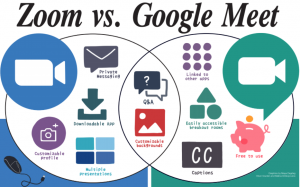Zoom
December 19, 2020
As COVID-19 cases skyrocket and the pandemic rages on, some SCHS classes have been using Zoom for distance learning. With a simple click of a button, students and teachers can virtually attend classes, club meetings and college webinars. While rival platform Google Meet offers similar functions, numerous students and staff members prefer Zoom.
Freshman Aasees Sandhu enjoys the flexible, user-friendly features Zoom provides. She likes toying with the moveable chat box and other features Google Meet has yet to integrate within their platform. Sandhu and her brother also experienced audio issues when using Google Meet on their personal laptops.
“It (Google Meet) just makes me so mad… I can get in, but the audio doesn’t come out unless I dial in,” Sandhu said. “There was a whole semester, we (Sandhu and her brother) had to dial in every day.”
Sophomore Kavi Rajesh also has experienced many connectivity issues while using Google Meet. She often uses Zoom over Meet to host large meetings. For her, lag issues become less evident, and she is fond of the chat feature that allows her to privately message her teachers, unlike the public chat on Google Meet.
“There’s some questions I would like to privately ask my teacher instead of it being public because it’s about my grades, or something that I don’t want my other classmates to know,” Rajesh said.
While many classes use Zoom, some staff members have struggled with preventing Zoom “bombings.” These bombings occur when an uninvited individual enters a call using a Zoom link and harasses or distracts the participants. Although the bombings take place on both Meets and Zoom, numerous users have observed that the bombings happen more frequently on Zoom. SCHS math teacher Lauren Hasty has been on the receiving end of multiple Zoom bombings.
“People got on and they used abusive language, and just shouted, and said stuff,” Hasty said. “That was very disruptive. We don’t want our students to have to listen to that stuff.”
In an attempt to rid these bombings, Zoom hurriedly created a “waiting room” feature. This gives meeting hosts the option to admit or deny entrance of individuals into their Zoom call. Nonetheless, the creation of this feature has formulated an issue in and of itself.
“Many students could find it tedious that if they’re late a minute or two, the teacher won’t check the waiting room, and they’ll be stuck in the waiting room for a while,” senior Ben Pham said.
Pham has found certain features specifically exclusive to Zoom to be extremely handy, namely the downloadable application feature. He appreciates how the Zoom application allows him to adjust the volume while multitasking.
“You can make Zoom a separate application from the rest of your computer,” Pham said. “For example, when you’re in a Zoom call and you have something else playing but the Zoom call is too loud, you can adjust the volume of the Zoom application to however you want. You can’t do that in Meet.”
As members of the Bruin community continue to live their lives virtually, both platforms continue to change and grow to meet their needs. Google Meet appears to be improving, having begun to integrate Zoom-like features within their own platform.
“Google Meet is like the baby and Zoom is like the parent,” Sandhu said. “Zoom is the improved version of Meets. Google Meet is still new, it needs to improve, it needs to grow up a bit, and Zoom’s already there.”


